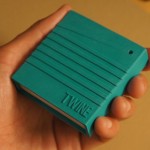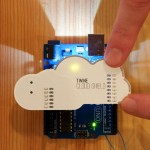When considering an Internet-of-Things framework for an existing or new project, one of the greatest challenges is getting the system running within what is most likely a tight deadline. And part of the greater challenge is the choice of interface between you devices and the network – and how will they interact? At this juncture your decision can be to create a bespoke solution, or use an existing product. The latter is ideal for proof-of-concepts, quick jobs or just when you need to get a MVP (minimum viable product) through the door. With this in mind, we’ll check out one example of an existing solution that you may make use of – called “Twine”
Although originally an idea that was brought to fruition using crowdfunding via Kickstarter, Twine has now become one of many viable choices in the IoT marketplace. As usual, it consists of a hardware and software component – so let’s examine those and then see how they can work together to solve your problems.
Hardware – The Twine devices are quite unassuming and compact, measuring approximately 70×71×20mm and can fit in the palm of your hand. With an elastomer coating they’re quite robust, however not water resistant or proof. These devices provide the link between the cloud-based software and a variety of hardware options. Inside each device already exists temperature, vibration and orientation sensors – and a port for external sensors. It connects via an 802.11b wireless network and is powered via a micro USB socket or 2 AAA cells.
You can also acquire a range of external sensors covering moisture, magnetic switches (for doors, etc) and also a breakout board to connect your own hardware. You can connect any device that outputs an analogue or digital signal with a 0~3.3 V range. Furthermore there’s also an Arduino shield for connection to that ubiquitous line of hardware. The last two options then give you the ability to quickly connect your own sensor or interface via an Arduino-compatible board other hardware with which you’d like to interact with over the cloud system. Therefore development costs of this additional hardware will be restrained due to the ease of interfacing with the sensor port or Arduino interface.
Software – There are two primary methods for interacting with the Twine hardware, with their proprietary cloud-based system or via HTTP to your own applications. Using the cloud-based method – you create a series of rules that can monitor incoming sensor data then make decisions based on the results. From simple things like email alerts notifying you of temperature changes to SMS text messages when a device has been physically moved – there are many possibilities that can be constructed in a short period of time. There’s also the option of receiving messages via twitter and text-to-voice call.
The process of creating applications for Twine doesn’t require any coding at all, so demonstrations of the system can be created and modified by general employees and management. Using an online drag-and-drop interface with simple condition parameters is used to generate actions based on the status of the connected sensors. However there is also the opportunity to have Twine directly interact with your own infrastructure using HTTP GET and POST requests. This is also preferable for those looking to keep their data within internal systems.
It can be said that Twine is not the most complex or customisable system on the market at the time of writing, however if your needs meet the capabilities then it can be a valid option. You can get a basic system operating in a few hours, and integrate other hardware in no time at all.
If you’re interested in moving forward with Twine or other platforms, we can guide you through the entire process, from simple installations for demonstration purposes to a complete system with customised external sensors and programming support. Our goal is to find and implement the best system for our customers, and this is where the LX Group can partner with you for your success.
We can discuss and understand your requirements and goals – then help you navigate the various hardware and other options available to help solve your problems. We can create or tailor just about anything from a wireless temperature sensor to a complete Internet-enabled system for you. For more information or a confidential discussion about your ideas and how we can help bring them to life – click here to contact us, or telephone 1800 810 124.
LX is an award-winning electronics design company based in Sydney, Australia. LX services include full turnkey design, electronics, hardware, software and firmware design. LX specialises in embedded systems and wireless technologies design. https://lx-group.com.au
Published by LX Pty Ltd for itself and the LX Group of companies, including LX Design House, LX Solutions and LX Consulting, LX Innovations.





